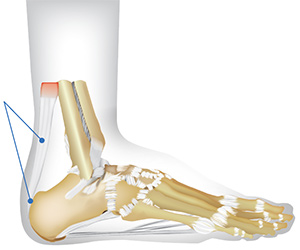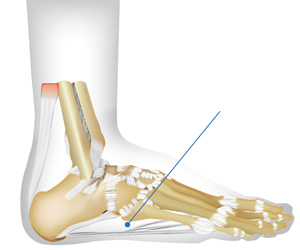Foot Pain Causes, Conditions and Treatments
The foot is an anatomical marvel in terms of its strength, flexibility, and functional design. It can support the weight of our entire body or even multiple times our body weight when we walk or run. With every step we take, the foot must absorb a tremendous amount of force and stress. The complexity of its makeup means that an injury or condition in one part of the foot (or ankle) can impact on adjacent bones or soft tissues, in some cases leading to more than one foot problem.
Foot anatomy diagram
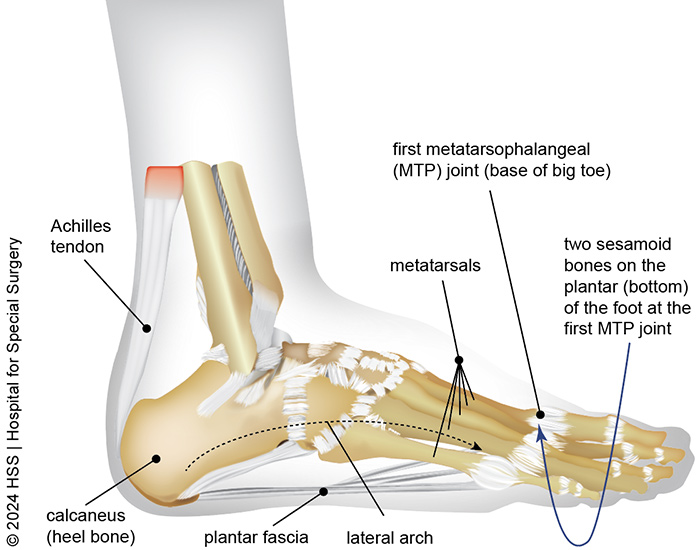
There are a total of 26 small bones in the foot, along with 33 joints and a network of more than 100 muscles, tendons and ligaments that work together to allow movement and stabilize our arches.
The arches of the foot are created by combination of bones and ligaments that are supported by a large area of connective tissue, called fascia, that spans the bottom of the foot. The plantar fascia is a long, thin ligament that lies directly under the skin, connecting the heel to the front of the foot.
Injuries and conditions that affect these various structures lead to pain symptoms in different areas of the foot. Learn about various conditions of the foot below. (For ankle issues, visit our Ankle Conditions and Treatments page.)
Foot pain chart
Damage or disease to any of the bones, tendons, ligaments, and other soft tissues can cause pain in whichever part of the foot they reside. However, pain by location in the foot can be a telltale sign of certain conditions.
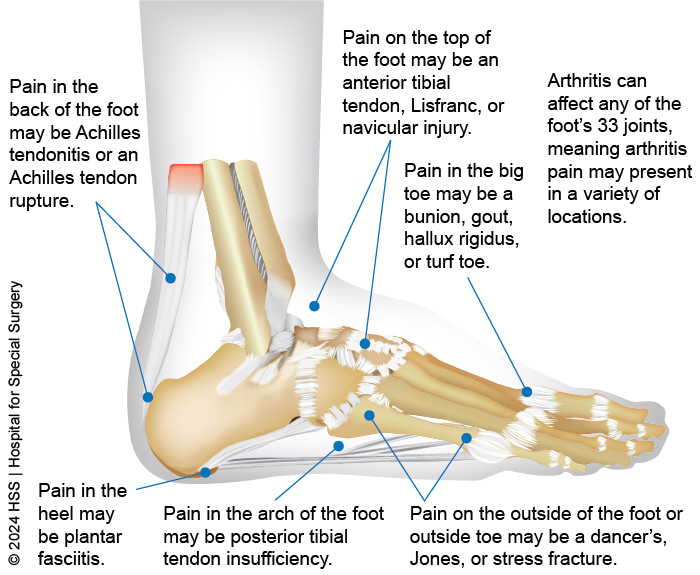
Where is your foot pain?
Top of foot pain
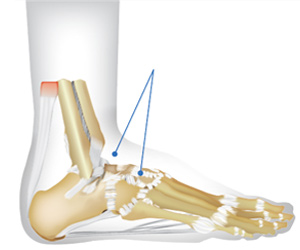
- Pain at the top of the foot near the ankle may be due to a stress fracture of the navicular bone. This is caused by repetitive force and is more commonly seen in athletes like basketball players and gymnasts.
- Pain at the top of the foot after an injury to the foot may be a Lisfranc injury, which is disruption of a strong ligament in the middle of the foot that holds up the arch.
- Pain at the top of the middle of the foot can be caused by arthritis in the small bones of the midfoot. Arthritis is the loss of cartilage in a joint and is typically due to wear and tear over time. The pain may be exacerbated when tying shoes too tightly.
- Similar to midfoot arthritis, pain on the top of the midfoot may be due to tendonitis of the anterior tibial tendon. This is typically an overuse injury of the tendon that helps you dorsiflex (bring the foot up off the ground).
- Pain at the top of the forefoot over the big toe is often caused by hallux rigidus, arthritis of the metatarsophalangeal (MTP) joint of the big toe. This condition is different from bunions and gout, which can affect the same area.
- Stress fracture of one or more metatarsal bones: Tiny cracks in the bone that are typically the result of overuse or repetitive force, often from high-impact activities like running or jumping. However, they can also occur due to normal use of a bone that’s weakened by a condition such as osteoporosis. The pain from a stress fracture usually starts off as barely noticeable, but it tends to worsen over time, particularly during or after weight-bearing activity. Other symptoms may include swelling on the top of the foot or the outside of the ankle, tenderness to touch, and increased pain during activities and decreased pain during rest.
Big toe pain
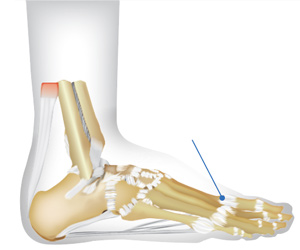
Pain at the base of the big toe is common to many conditions, including:
- Gout: The joint in the big toe is the most likely joint to be affected by gout, which causes pain, swelling, and tenderness. A gout attack may be accompanied by chills and a low fever. If untreated, the attack generally peaks within 24 hours and may linger for weeks.
- Hallux rigidus: This is a form of degenerative arthritis that can cause severe pain in the big toe. It's characterized by stiffness and restricted range of motion in the metatarsophalangeal (MTP) joint.
- A bunion (hallux valgus) is a bony protrusion that forms at the base of the big toe (also known as the first MTP joint. This condition can lead to significant discomfort and difficulty in walking.
- Hammertoe is a deformity where one or more of the smaller toes become bent downward in a manner that resembles the curve of a claw hammer. They may also sometimes bend somewhat laterally (sideways) into or even crossing over other toes. This condition is particularly painful while wearing shoes with narrow toe boxes.
- Morton's neuroma: This is a painful foot condition that occurs when a nerve in the foot becomes irritated and thickens. It often affects the area between the third and fourth toes.
- Turf toe: Turf toe is a sprain of the main joint of the big toe. It typically occurs when the toe bends upward too far, which can happen during sports.
Outside of foot pain
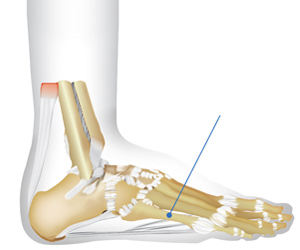
Pain in the outside foot (lateral aspect) or pain in the inside of the foot (medial aspect) maybe caused by injury to the bones or soft tissues such as:
- Arthritis in the joint below the ankle called the subtalar joint may be a cause of pain on the lateral aspect of the foot.
- A fracture, or break, of the fifth metatarsal bone is a common cause of pain on the outside of the foot following an inversion injury to the foot. This can occur at the base of the bone (Jones fracture) or closer to the toes (dancer’s fracture).
- Stress fractures may also occur in the fifth metatarsal bone especially in patients with high-arched feet.
- Tendon and/or ligament inflammation or degeneration (including posterior tibial tendon insufficiency on the inside of the foot or peroneal tendonitis on the outside of the foot).
- Stretched, torn, or pinched nerves (especially those passing through the ankle).
- Cuboid syndrome (subluxation of the midtarsal joint) is a condition where the cuboid bone becomes malaligned in relation to the calcaneus bone.
Back of the foot pain – Achilles tendon conditions
Achilles tendon conditions include:
- Achilles tendonitis is inflammation to the Achilles tendon that links your calf muscles to your heel bone. The pain may be at the insertion of the Achilles tendon (Haglund’s deformity) on the heel bone (calcaneus). Insertional Achilles tendonitis may be associated with retrocalcaneal bursitis, which is an inflammation of the retrocalcaneal bursa (a small cushioning sac between the heel bone and the Achilles tendon).
- Achilles tendon ruptures are tears of the Achilles tendon and often associated with a “pop” in the back of the ankle felt during physical activity. They can be painful and debilitating and may require surgery to recover from.
Bottom of foot pain
Conditions causing pain at the bottom can be categorized, generally, by whether the pain resides in the ball (forefoot), arch (midfoot), or heel (hindfoot).
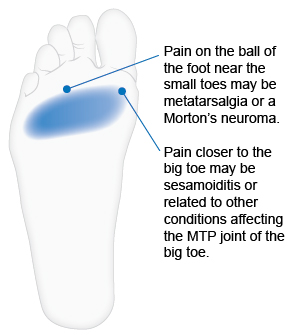
Pain in the ball of the foot
Pain in the ball of your foot can stem from any one of these conditions:
- Sesamoiditis is inflammation of the small bones shaped like sesame seeds located beneath the big toe joint.
- Arthritis in one or more MTP joints can also lead to stiffness and pain in the ball of the foot.
- Morton's neuroma is a benign growth of nerve tissue usually located between the third and fourth metatarsal heads, can cause pain in the ball of the foot.
- Metatarsalgia is a broad term that refers to pain under the metatarsophalangeal (MTP) joints (where the metatarsal bones meet the phalanges or toe bones), which can arise from various conditions.
- Bunions are bony bumps that form on the joint at the base of your big toe, sometimes cause pain in the ball of the foot as a result of the big toe's poor alignment as increased force is transferred under the adjacent bones. This is a common cause of metatarsalgia.
Foot arch pain
Pain in the arch of the foot can be attributed to several conditions:
- Flatfoot, has many names and is also known as progressive collapsing foot deformity, adult acquired flatfoot deformity, posterior tibial tendon insufficiency, or “fallen arches,” is characterized by a shallow or absent arch on the inner side of the foot. The absence of the arch can cause increased stress on the foot's structures including the bones, ligaments, and tendons, leading to pain in the arch and potentially other areas of the foot.
- Conditions in the forefoot or hindfoot can also sometimes lead to secondary symptoms in the arch. For example, Morton's neuroma can result in a sensation similar to walking on a pebble, which may cause discomfort in the arch.
Heel pain
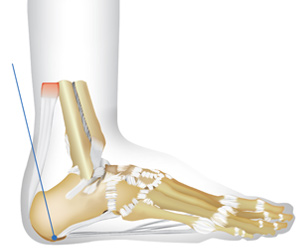
Heel pain is a common ailment that can be caused by several factors, often related to strain or injury.
- Plantar fasciitis, an inflammation of the plantar fascia – a band of tissue that runs across the bottom of your foot from your heel bone to the base of your toes. This condition can result from chronic trauma such as running in unsupportive shoes, or it may occur spontaneously without any clear reason. In some people, the specific biomechanics of their feet, such as high arches, may increase the likelihood of developing plantar fasciitis.
- Heel spurs do not usually cause pain in and of themselves but are often seen on X-rays and may be seen in conjunction with plantar fasciitis or Achilles tendon pain.
When to see a doctor for foot pain
A significant injury to your foot in which you have trouble weightbearing afterwards, or if you have significant bruising or swelling two to five days after an injury should prompt a visit to a doctor. Additionally, if you have lingering pain in your foot two to three weeks after an injury, then you should consider seeing a physician. You should also consider making an appointment with a doctor if you have persistent, or chronic pain, that doesn’t resolve after several weeks of rest or pain in your foot that is worsening over time. Burning, tingling, or numbness may be signs of nerve damage, and it’s important to have your foot evaluated if you suffer from those symptoms.
Browse foot conditions
Learn about specific conditions of the foot below. For ankle issues, visit our Ankle Conditions and Treatments page.
- Accessory Navicular
- Arthritis of the Foot and Ankle
- Arthrodesis (Fusion)
- Benign Bone Tumor
- Bone Lesion
- Bunions
- Cavus Foot
- Charcot-Marie-Tooth Disease
- Clubfoot
- Compound Fracture
- Flatfoot
- Fractures of the Foot
- Gout
- Haglund's Deformity
- Hallux Rigidus (Stiff Big Toe)
- Hammertoe
- Orthotics
- Osteosarcoma (Bone Cancer)
- Outpatient Surgery: Frequently Asked Questions
- Plantar Fasciitis
- Posterior Tibial Tendon Dysfunction
- Psoriatic Arthritis
- Sarcoidosis
- Soft-Tissue Sarcoma
- Stress Fracture: When a Bone Breaks from Repetitive Stress
- Tendon Injuries and Conditions
- Tendon Ruptures
Foot Pain Causes, Conditions and Treatments Success Stories
Posted: 2/16/2024
Reviewed and edited by Matthew S. Conti, MD

